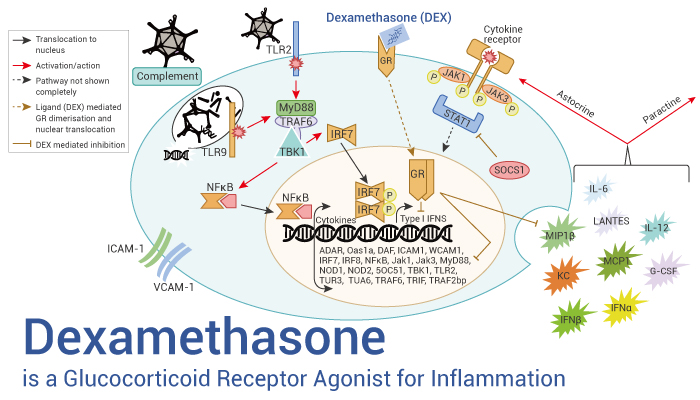Glucocorticoid Receptor (GR, or GCR) also known as NR3C1 is the receptor to which cortisol and other glucocorticoids bind. The GR is expressed in almost every cell in the body and regulates genes controlling the development, metabolism, and immune response. When the glucocorticoid receptor binds to glucocorticoids, its primary mechanism of action is the regulation of gene transcription. The activated GR complex up-regulates the expression of anti-inflammatory proteins in the nucleus or represses the expression of pro-inflammatory proteins in the cytosol by preventing the translocation of other transcription factors from the cytosol into the nucleus. Upon ligand binding, the cytoplasmic GR dimerizes and translocates to the nucleus where it can enhance transcription by binding cooperatively as a homodimer to glucocorticoid response elements (GREs).

Dexamethasone (also known as Hexadecadrol or Prednisolone F), the glucocorticoid, is a glucocorticoid receptor agonist.
Dexamethasone is a synthetic glucocorticoid previously shown to induce transcription of IκBα, the cytoplasmic inhibitor of NF-κB, thereby suppressing the expression of proinflammatory cytokines including IL-1, IL-6, IL-8 and TNF-α, and cell adhesion molecules involved in migration of leucocytes into the extravascular space (endothelial leucocyte adhesion molecule-1 and ICAM-1). In addition, Dexamethasone also significantly decreases CD11b, CD18, and CD62L expression on neutrophils, and CD11b and CD18 expression on monocytes. Moreover, Dexamethasone down-modulates the inflammatory cascade through two main mechanisms: (i) suppression of the early inflammatory response in lung macrophages by down-regulation of proinflammatory cytokines, and (ii) inhibition of MIP-1α-induced migration and activation of neutrophils. Surprisingly, Dexamethasone is highly effective in the control of COVID-19 infection.
To sum up, Dexamethasone is a glucocorticoid receptor agonist with potent anti‐inflammatory and immunosuppressive effects.
Reference:
[1] D Rocksén, et al. Clin Exp Immunol. 2000 Nov;122(2):249-56.
[2] Evangelos Andreakos, et al. Allergy. 2021 Mar;76(3):626-628.